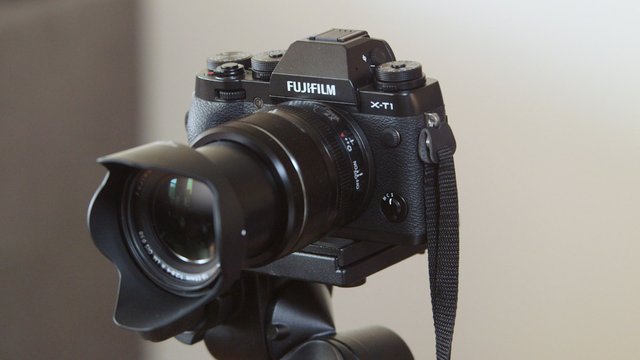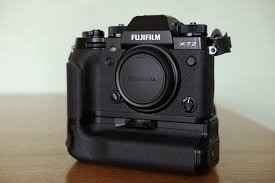Fujifilm's X-T2 is the ideal mirrorless camera for photograph nerds. It appears as though that is valid for each camera that Fujifilm discharges, however the X-T2 is a refined spin-off of the X-T1 that enhances its ancestor in the ways that issue most: determination, self-adjust, and usability. It's still got all the manual control dials and shocking electronic viewfinder that baited picture takers to the X-T1. At $1,599 (or $1,899 with a packaged 18-55mm focal point), it's in reality more costly than the X-T1's unique beginning cost. In any case, when it's entirely stock some place once more, I'll be getting one.

Following quite a while of experimenting with the X-T2, I've come to confide in it like couple of cameras I've utilized already — notwithstanding tallying full-outline DSLRs. There are still situations where $3,000 Canon and Nikon cameras can helpfully best Fujifilm, however the experience of shooting with the X-T2 is sublime to the point that you'll experience serious difficulties discovering them. We portrayed the X-T1 as an "immaculate, no-bargains mirrorless camera." But, obviously, it wasn't flawless, and mirrorless cameras have enhanced at each edge since 2014. The X-T2 is Fujifilm's endeavor to secure the best spot from rivals, and the camera pulls off that mission brilliantly.
A first look may have you trust that Fujifilm scarcely changed a thing with the X-T2's plan. And keeping in mind that it maintains an almost indistinguishable, SLR-styled body, there are distinct changes — the greater part of them to improve things. The camera's hand grasp is marginally more profound and more agreeable. That, joined with a bigger thumbrest makes the X-T2 less demanding to grasp for extensive stretches in the event that you have huge hands. The camera is still developed from magnesium compound and climate fixed, and Fujifilm's determination of rain-safe focal points has developed significantly since the X-T1's discharge. The X-T2 incorporates the greater, more immersive eyecup that was an independent extra for its antecedent.
THE XT-2'S MANY DIALS AND BUTTONS GIVE YOU EXPERT CONTROL OVER YOUR IMAGES
At that point there are the physical controls that photograph geeks adore. Fujifilm has changed the locking instrument for the screen speed and ISO dials, making it path less difficult to modify those settings on the fly. You simply press once to open, and again to secure your present determination to keep it from unintentionally being changed amid shooting. Fujifilm again gives clients six capacity catches, in addition to devoted autoexposure and self-adjust catches. There's another "custom" setting on the introduction remuneration dial that gives you a chance to flick the camera's front charge dial for quicker modifications. Fujifilm has likewise included a fourth metering mode: focus weighted.
Missing is the video record catch that was on the X-T1; since the X-T2 is equipped for 4K recording, video has earned its own spot on the drive dial. What's more, the Wi-Fi catch has been repurposed, so you'll have to dole out that to a capacity key on the off chance that you every now and again exchange pictures specifically to your cell phone for Instagramming, as I do. Fujifilm's cell phone application, accessible for Android and iOS, works similarly as dependably here likewise with the X-T1, however I've seen that sending photographs over to my iPhone 7 is much slower than before — maybe due to the bigger record sizes. The extraordinary multi-directional concentration stick has been brought over from the X-Pro 2, put right where your thumb normally meanders.
The electronic viewfinder that was one of the X-T1's enormous draws has likewise been moved forward. It's brighter, smoother (60fps as a matter of course), and Fujifilm added an auto-brilliance setting to keep it coordinated to your shooting condition. Turn on the X-T2's lift mode and the viewfinder changes over to a ultra-smooth 100fps invigorate rate. This can be a noteworthy help when shooting activity subjects and makes peering through the extensive OLED EVF significantly additionally dumbfounding, however it drains the camera's battery snappier.
The X-T2's 3-inch raise LCD show — unaltered in sharpness at 1.04 million specks (somewhat not as much as the X-Pro 2's LCD) — would now be able to express outward and tilted to one side. That is decent for picture takers who frequently shoot in representation introduction, however I scarcely ever utilized the new point. Much the same as the X-T1, I for the most part utilized the tilting show when shooting from a down and out or high-up point of view where glancing through the EVF wasn't achievable. It is anything but a touchscreen, as Fujifilm demands that is not something its propelled clients need. Other equipment enhancements incorporate an extra SD card space, so the X-T2 can keep in touch with two UHS-II cards at the same time. Fujifilm likewise included a 3.5mm amplifier jack on the off chance that you need an option that is superior to the inherent mics for video. It's likewise USB 3-perfect, so exchanging photographs when fastened is significantly less difficult than previously.

The X-T2 to a great extent feels like the camera it succeeds, yet begin shooting and that is the place the most profound changes wind up self-evident. The X-T2's 24.3-megapixel APS-C X-Trans sensor delivers perceptibly more nitty gritty photographs than the 16-megapixel sensor in the X-T1. It enables that Fujifilm's unit to package incorporates the awesome 18-55mm (f/2.8 - 4) focal point, which surpasses the vast majority of the pack-in focal points that go with different cameras. I'm frustrated there's no bundle that incorporates the do-everything 18-135mm focal point that invested 95 percent of the energy joined to my X-T1, however ideally that will come later on. In any case, in case you're purchasing the X-T2, it merits spending the additional $300 for the 18-55 focal point. Local ISO currently goes up to 12,800, and the greatest mechanical shade speed has bounced to 1/8000sec contrasted with the 1/4000 roof the X-T1 had.
Fujifilm has drastically enhanced self-adjust execution and adaptability on the X-T2. As a matter of course you get 91 self-adjust focuses with 49 stage recognize focuses taking up the middle. For more granular concentration control, you can change over to an extended 325-point setting, where 169 of those are stage distinguish. Once more, better when you're following moving subjects with either the Zone or Wide/Tracking AF modes — and the concentration stick is a gigantic help when endeavoring to enter in such exact core interest. In either case, stage recognize self-adjust focuses cover around 40 percent of the casing. Fujifilm says the X-T2 can hit center in lighting as low as - 3EV, and the camera was extremely reliable I would say. (On the other hand, so was the X-T1 after some firmware refreshes.)
Self-adjust KEEPS UP WITH SPORTS AND ACTION MUCH BETTER
Be that as it may, where the X-T1 could battle with activity/sports photography and quick moving subjects, these issues appear to be totally settled with the new camera. Fujifilm cases to have enhanced its persistent self-adjust calculations, and my testing bears that out. The X-T2 had no issue following the activity at a novice boxing night. Ceaseless shooting tops out at 8fps, however you can stretch out that to 11 shots-per-second in the event that you have the discretionary battery hold connected. The battery grasp additionally stretches out 4K recording to 30 minutes from the standard cutoff of 10, and includes an earphone jack for sound observing. It can likewise hold two batteries, permitting utilization of three batteries for marathon shooting sessions. Battery life is as yet a shortcoming of numerous mirrorless cameras, so conveying a charged extra in my sack is something I've modified into my cerebrum in the course of the last couple years. The battery hold's advantages require a major included cost however: it's $329, which is just somewhat not as much as Fujifilm's incredible 35mm f/2 focal point.
The X-T2 produces stunning JPEGs that have moved toward becoming maybe the greatest mark of Fujifilm cameras. Here and there I'll shoot in RAW since you've generally got the choice to reprocess pictures with those film recreations later, however you can skip RAW in numerous occasions and leave away with incredible hues and tones. Having the capacity to skip Lightroom and postprocessing completely and get great photographs straight out of camera is such a convincing motivation to pick Fujifilm. You can likewise apply those film reproductions to video, which would now be able to be shot in 4K at 24p, 25p, or 30p. The X-T2 offers shockingly solid video highlights, similar to the capacity to shoot ungraded, level F-Log film. In any case, regardless of whether Fujifilm is getting more genuine about video, it'll remove a ton to draw individuals from organizations like Sony and Panasonic, who've concentrated on record for a considerable length of time. This is as yet a camera that most purchasers will utilize transcendently for stills.
You don't have to purchase the X-T2 (or Fujifilm's other costly leader, the X-Pro 2) for those incredible pictures, however. The X100T remains a magnificent camera to bear in a sack. The X-T2 is for the individuals who have proficient or prosumer use as a top priority and need the camera's bursting quick concentration, tried and true execution, and amazing outcomes. It's not Fujifilm's most straightforward camera to carry around, but rather it's presently the best camera in the organization's line. There's only a delight that accompanies shooting with the X-T2. That is valid for some cameras, yet in the event that you officially possess a Fujifilm camera and "get it," you're likely effectively endeavoring to talk yourself out of purchasing the X-T2. I can't help you there; your fundamental test right presently will be really discovering one.

